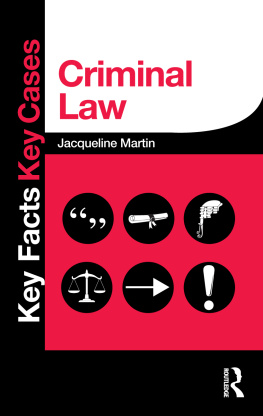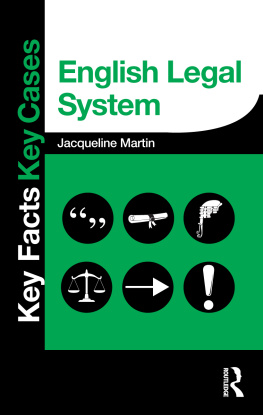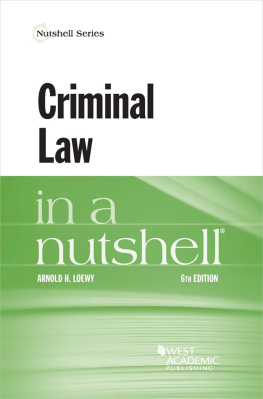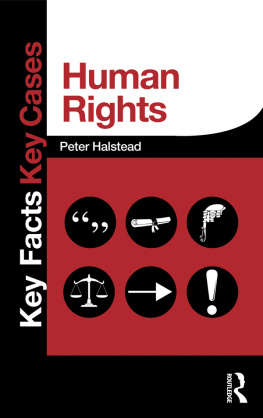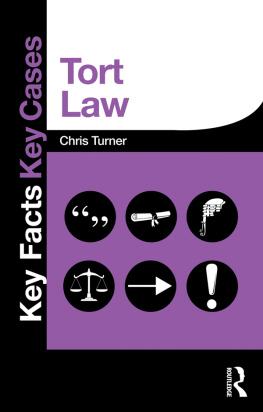
KEY FACTS KEY CASES
Criminal Law
KEY FACTS KEY CASES
The Key Facts Key Cases revision series is designed to give you a clear understanding and concise overview of the fundamental principles of your law course. The books chapters reflect the most commonly taught topics, breaking the law down into bite-size sections with descriptive headings. Diagrams, tables and bullet points are used throughout to make the law easy to understand and memorise, and comprehensive case checklists are provided that show the principles and application of case law for your subject.
Titles in the series:
Contract Law
Criminal Law
English Legal System
Equity & Trusts
EU Law
Family Law
Human Rights
Land Law
Tort Law
For a full listing of the Routledge Revision range of titles, visit www.routledge.com/law
KEY FACTS KEY CASES
Criminal Law
Jacqueline Martin

First published 2014
by Routledge
2 Park Square, Milton Park, Abingdon, Oxon OX14 4RN
and by Routledge
711 Third Avenue, New York, NY 10017
Routledge is an imprint of the Taylor & Francis Group, an informa business
2014 Jacqueline Martin
The right of Jacqueline Martin to be identified as author of this work has been asserted by her in accordance with sections 77 and 78 of the Copyright, Designs and Patents Act 1988.
All rights reserved. No part of this book may be reprinted or reproduced or utilised in any form or by any electronic, mechanical, or other means, now known or hereafter invented, including photocopying and recording, or in any information storage or retrieval system, without permission in writing from the publishers.
Trademark notice: Product or corporate names may be trademarks or registered trademarks, and are used only for identification and explanation without intent to infringe.
British Library Cataloguing in Publication Data
A catalogue record for this book is available from the British Library
Library of Congress Cataloging in Publication Data
A catalog record for this book has been requested.
ISBN: 9780415833257 (pbk)
ISBN: 9781315871677 (ebk)
Typeset in Helvetica
by RefineCatch Limited, Bungay, Suffolk
This new series of Key Facts Key Cases is built on the two well-known series, Key Facts and Key Cases. Each title in the Key Facts series now incorporates a Key Cases section at the end of most chapters, which is designed to give a clear understanding of important cases. This is useful when studying a new topic and invaluable as a revision aid. Each case is broken down into fact and law. In addition, many cases are extended by the use of important extracts from the judgment or by comment or by highlighting problems. In some instances, students are reminded that there is a link to other cases or material. If the link case is in another part of the book, the reference will be clearly shown. Some links will be to additional cases or materials that do not feature in the book.
The basic Key Facts sections are a practical and complete revision aid that can be used by students of law courses at all levels from A-level to degree and beyond, and in professional and vocational courses.
They are designed to give a clear view of each subject. This will be useful to students when tackling new topics and is invaluable as a revision aid.
Most chapters open with an outline in diagram form of the points covered in that chapter. The points are then developed in a structured list form to make learning easier. Supporting cases are given throughout by name and for some complex areas facts are given to reinforce the point being made. The most important cases are then given in more detail. The cases that feature in the Key Cases sections are given in blue in the ordinary text to alert students to that fact.
The Key Facts Key Cases series aims to accommodate the syllabus content of most qualifications in a subject area, using many visual learning aids.
Some areas of criminal law are very complex and this book helps students by breaking down each topic into key points. This is done for the general principles such as actus reus and mens rea and also for the specific offences. The topics covered make it a useful resource for criminal law components of degree courses, ILEX courses and A-level specifications.
cover substantive areas of law.
In the Key Cases sections in order to give a clear layout, symbols have been used at the start of each component of the case. The symbols are:

| Key Facts These are the basic facts of the case. |

| Key Law This is the major principle of law in the case, the ratio decidendi. |

| Key Judgment This is an actual extract from a judgment made on the case. |

| Key Comment Influential or appropriate comments made on the case. |

| Key Problem Apparent inconsistencies or difficulties in the law. |

| Key Link This indicates other cases which should be considered with this case. |
The Key Link symbol alerts readers to links within the book and also to cases and other material especially statutory provisions that are not included.
The court abbreviations used in the key case sections of this book are shown below.
Ass | Assize Court | CA | Court of Appeal |
CC | County Court | CCA | Court of Criminal Appeal |
CCR | Crown Cases Reserved | CH | Court of Chancery |
ChDiv | Chancery Division | CJEU | Court of Justice of the European Union |
C-MAC | Court Martial Appeal Court | CP | Court of Probate |
DC | Divisional Court | EAT | Employment Appeal Tribunal |
ECHR | European Court of Human Rights | ECJ | European Court of Justice |
ET/IT | Employment tribunal/Industrial tribunal | Exch | Court of the Exchequer |
HC | High Court | HL | House of Lords |
KBD | Kings Bench Division | NIRC | National Industrial Relations Court |
PC | Privy Council | QBD | Queens Bench Division |
RC | Rolls Court | SC | Supreme Court |
The law is as I believe it to be at June 2013.
Next page
